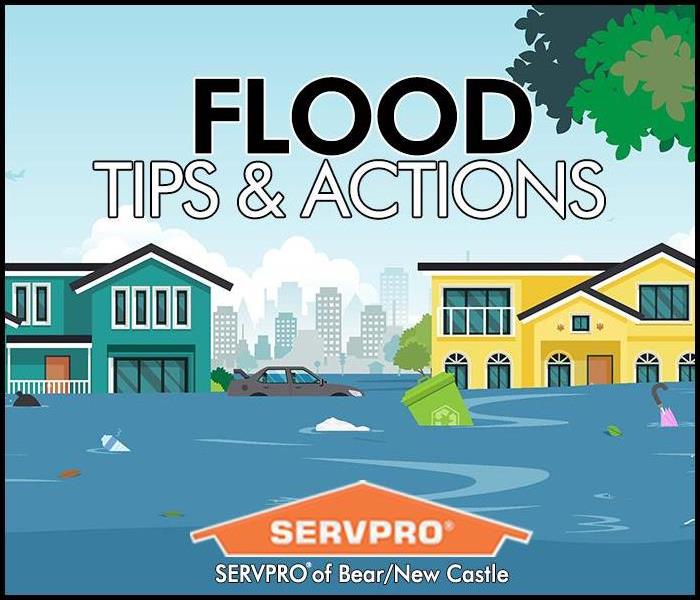Flood Tips & Action Steps
6/16/2020 (Permalink)
 SERVPRO of Bear/New Castle's quick response will help prevent secondary damage and help reduce restoration costs.
SERVPRO of Bear/New Castle's quick response will help prevent secondary damage and help reduce restoration costs.
Floods rank as one of the most common and widespread natural disasters in the United States. Whether you live near a coastline, along city streets, in the mountains, near a river or even in the desert, there is a potential for suffering flood damage. In fact, nearly 25% of last year’s claims paid by the National Flood Insurance Program (NFIP) were for policies in moderate to low-risk communities. On average, floods cost $6 billion in annual losses in the U.S. Flooding can also result from plumbing failures, frozen pipes and damaged structures. Flood damage can affect your business operation in a variety of ways and can range in size from being isolated to a single room to entire floors being fully submerged.
Knowing how to prepare and deal with potential flooding in advance can affect how much of your property can be restored and how much has to be replaced. Below are prevention, mitigation and restoration tips to follow until help arrives:
Flood Prevention Tips:
- Determine if your property is in a floodplain.
- In any emergency, always listen to the instructions given by local emergency management officials.
- Carefully assess how your company functions, both internally and externally, to determine which staff, materials, procedures and equipment are absolutely necessary to keep the business operating.
- Plan what you will do if your building, plant or store is not accessible. This type of planning is often referred to as a continuity of operations plan, or COOP, and includes all facets of your business.
- Plan for payroll continuity.
- Review your emergency plans annually. Just as your business changes over time, so do your preparedness needs. When you hire new employees or when there are changes in how your company functions, you should update your plans and inform your people.
- Visit: ready.gov/america/local/index.html for a comprehensive plan and to learn about emergency plans for your state.
Flood Action Steps:
BEFORE A FLOOD
If an advanced Flood Warning has been issued, there are several precautions that can be taken to help minimize damage to certain areas of your business:
- Turn off utilities at the main switches or valves if instructed to do so.
- Disconnect electrical equipment and appliances.
- Move vehicles out of low-lying parking garages.
- Raise elevators from bottom floor.
AFTER A FLOOD
SAFETY FIRST
- Account that all employees are safe by establishing evacuation plans in advance, identifying areas outside the building that are designated meeting places. Assign select individuals to keep a list of their assigned team’s names and contact numbers in order to account for their whereabouts.
- If water enters the building and evacuation becomes impossible, move to an upper floor, and wait for rescuers.
- While evacuating, avoid attempting to drive through floods or rising water, nearly half of all flash flood fatalities are auto-related.
- Do not touch electrical equipment if you are wet or standing in water.
- Do not walk through moving water. Even six inches of moving water can make you fall.
- Use no open flames (there may be gas escaping from ruptured mains).
- Avoid floodwaters. Water may be contaminated by oil, gasoline or raw sewage. Water may also be electrically charged.
- Stay out of any building if it is surrounded by floodwaters.
- Listen for news reports to learn if the community’s water supply is safe to drink.
- Return only when authorities indicate it is safe.
SECURE THE PROPERTY
- Contact local emergency officials.
- Secure main entrances to building.
- Alert Security company and Alarm company of the situation.
STABILIZE THE PROPERTY
- Shut off the source of water if possible or contact a qualified party to stop the water source.
- Give priority to the protection of power plant and fire pumps, keeping them in service if at all possible.
- Open basement or low-level windows to equalize water pressure on the building’s foundation and walls.
- Begin water damage mitigation steps only if local emergency officials deem the structure safe to enter.
- Notify your insurance agent or Risk Manager to determine insurance policy guidelines and steps to take.
Have Storm or Flood Damage?
Call SERVPRO of Bear/New Castle (302) 392-6000
Why Choose SERVPRO of Bear/New Castle?
When you are dealing with storm, flood, and water damage, immediate action is crucial. You should choose the company with storm damage experience and expertise that has the resources and equipment to handle the job. SERVPRO of Bear / New Castle can respond immediately to storm and flooding conditions.






 24/7 Emergency Service
24/7 Emergency Service